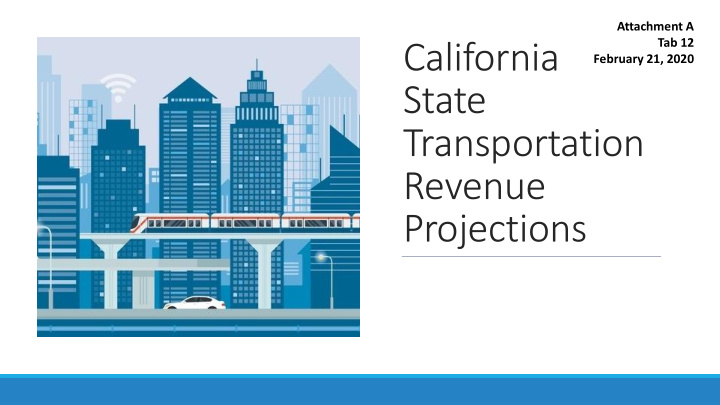



Attachment A Tab 12 California February 21, 2020 State Transportation Revenue Projections
STATE E TRANSPORTATION N RELATED D REVENUES S Overview w of f California a Transportation n Revenues s Overall, California transportation funding consists of state, federal, and local funds. This graphic shows the major components of state funds. FY 17/18 - FY 24/25 revenues
Fuel Consumption No Longer Increases in Proportion to Vehicle Miles Traveled 30% Vehicle Miles Traveled Consumption 25% 20% Growth (1994 Base Year) 15% 10% 5% 0% 1994 1998 2002 2006 2010 2014 2018 Notes: Vehicle miles traveled data from US Federal Highway Administration Gasoline consumption data from California Department of Tax and Fee Administration 3
Key y Datasets s for r Projections s Transportation revenue projections rely on assumptions about many factors for which there is considerable uncertainly, including: # of vehicle Population # of vehicles miles traveled size (VMT) Gasoline and Adoption diesel fuel Inflation rates rates for ZEVs prices
UC C Davis s Projections s - 4 Gas s Tax x + + RIF IF Annual revenue (billions of $) (Z (ZEV) ) Fee e Only y 3 Projections are a function of: ◦ Fleet size 2 ◦ Fuel economy (and improvements for new vehicles) 1 ◦ Number of ZEVs ◦ VMT 0 Revenue decreases over time as fuel economy of new vehicles 2020 2022 2024 2026 2028 2030 Year improves Revenue Source ZEV fee recovers part of the Gasoline Tax decrease in revenue but most of Gasoline Tax + ZEV Fee the deficit is from fuel economy improvements
Mineta a Transportation Institute e s – Projections State e Fuel l Related d Revenues s Only y Includes the following projected revenues: ✓ Gasoline Excise Tax ✓ Incremental Gas Tax ✓ Diesel Excise Tax ✓ Diesel Sales Tax
Mineta a Transportation Institute e Projections s – State e Fuel l Related d Revenues s + + TIF F and d RIF F Looks at the impact of ZEV adoption on revenue Includes the following projected revenues: ✓ Transportation Improvement Fee (based on value of car) ✓ Road Improvement Fee (ZEV) ✓ Gasoline Excise Tax ✓ Incremental Gas Tax ✓ Diesel Excise Tax ✓ Diesel Sales Tax
National l Fuel l Tax x Revenue e Projections s Red Line: Total fuel tax revenues if 2017 CAFE mpg levels remained constant. Green Line: Impact of 2025 mpg requirements over next two decades. Yellow Line: Adds to the previous line the impact of an electric vehicle penetration estimate from Bloomberg New Energy Finance. Key differences from CA: • This graph assumes an average State and federal tax of $.47 per gallon, but CA has a higher state excise tax beginning around 2021 for gas and 2031 for diesel. From Bob Poole report, “How a State Could Transition from Per -Gallon Taxes to Per-Mile Charging,” originally from Ed Regan, “The Motor Fuel Tax: A Critical System at Risk.” CDM • California has RIF and TIF revenues. Smith. 2017
CALIFORNIA A FUEL L USE E AND D VEHICLE E MILES S TRAVELLED D Fuel is shown in million of gallons, VMT is shown in millions of miles. 600,000 500,000 Mineta VMT projections 400,000 Caltrans VMT 300,000 200,000 100,000 CDTFA gas & diesel consumption Mineta gas & diesel consumption projections - Data Sources: • Department of Tax and Fee Administration: http://www.cdtfa.ca.gov/taxes-and-fees/spftrpts.htm • Mineta Transportation Institute: https://transweb.sjsu.edu/research/1850-California-Fuel-Tax-Futures • Caltrans: https://dot.ca.gov/programs/research-innovation-system-information/highway-performance-monitoring-system
• Reasons to pursue In general, SB 1 slowed road charge are: the process of revenue A road charge is To keep in line with national changes decline, allowing the most viable • To encourage equity California more time to long-term for taxpayers research and implement solution. • To prepare for the a road charge. future • To align with environmental policy Conclusion n
Questions?
Recommend
More recommend